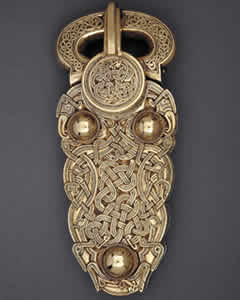Sutton Hoo
I saw my first dead body at Sutton Hoo. True, the chap had been dead for centuries, and was little more than a dark, man shaped bulge against the orange soil, but to a six year old, that's still pretty darned cool. That and the fact that the man giving us the tour insisted I come right to the front, and held everything down for me to see.
Sutton Hoo web site:
Sutton Hoo is a group of low grassy burial mounds overlooking Woodbridge and the River Deben in SE Suffolk, England. In 1939 excavations brought to light the richest burial ever discovered in Britain, an Anglo-Saxon ship containing the treasure of one of the earliest English Kings, Rædwald, King of East Anglia. Further excavations, completed in 1992, proved the site to be a complex collection of burials, some royal, others possibly the victims of judicial execution. Most recently, excavations in advance of building work in 2000, uncovered the remains of another, earlier cemetery, 500m north of the main mound cemetery.
Rædwald was king of East Anglia from 599 AD to about 625 AD. The gold belt buckle was found in the 1939 dig, and the ship they unearthed was 27 metres (90 ft) long.

The buckle was made from nearly 15 ounces of solid, high karat gold. It was pretty big for a buckle. I've got a soft spot for Sutton Hoo.
St Louis has no Saxon burial grounds. I do miss the feeling of knowing that under your feet there is probably something of archaeological significance. No-one was very surprised that the new Waterstone's book store in Guildford (used to live there) excavated their site before building, it was more a question of what they would find. The store opened with display cases on the walls showing pottery fragments, a pipe, and other bits and pieces. There is a church in Reading (used to go there a lot) that was build in 979 AD, and still used today. Ipswich (where I grew up) had a decent collection of Constable paintings, because he was a local man. The Victoria and Albert Museum in London pinched the best ones, like the Haywain, but we had some housed in Christchurch Mansion, the centrepiece of a 100 acre park in the town centre. Colchester, the oldest Roman settlement in the country, has a castle with a museum in where I saw my second dead body, a mummy in a casket. Bury St. Edmunds has the ruins of an abbey, Framlingham Castle is pretty well preserved, as is Orford Castle. Then there's the more recent WWII tank training ground at Landguard Point in Felixstowe, all ridges, hills, ditches and mounds.
In many British towns, if you look above the shop level to the next floor, there is some stunning architecture, Tudor timbers, elaborate carvings, elegant brickwork. There is also some horribly ugly concrete and bland modern brickwork, but you learn not to see that. When we visit England, I get my architecture fix, especially in London. We have a painting of Guildford that people often assume is a historical view of the town, but it's actually modern. They just didn't change much, the electrical cables are kept out of sight, and the cobblestone road was turned into a pedestrianised zone.
